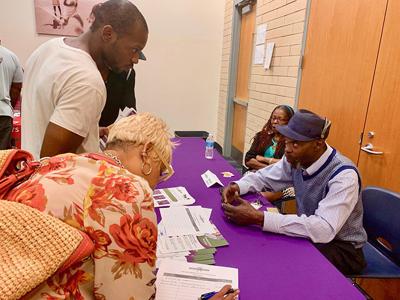
More than 1,000 workers could be employed daily in 2022 during peak construction of the National Geospatial-Intelligence Agency’s new $1.75 billion facility project, which broke ground on November 26.
This is a tremendous opportunity to implement the City of St. Louis’ law for employing local residents, minorities, women and apprentices, according to advocates and union leaders.
The city’s inclusion goals require that a minimum of 25 percent of the contract’s labor hours go to minorities, 7 percent go to women, 23 percent to city residents and 20 percent to apprentices.
In 2016, the U.S. Army Corps of Engineers (USACE) officials, which is overseeing design and construction, told The St. Louis American that the agency can only adopt federal workforce goals of 14.7 percent minority and 6.9 percent women on the N.G.A. project.
However, members of the McCarthy-HITT joint venture team leading the project’s construction said that they have taken it upon themselves to implement the city’s goals.
“We have our contractual goals and our internal goals, but those are just numbers,” Heather Cirre, small business manager for the McCarthy-HITT team. “We are really interested in maximizing the participation of the community around us, based on what the marketplace will support.”
For them, the project is also an opportunity to build a pipeline of apprentices and address the issue of attrition in the trades, Cirre said.
Jeff Boyer, McCarthy’s vice president of operations, said that while the U.S. Army Corps of Engineers could not mandate higher workforce goals, the agency’s leaders are excited that McCarthy-HITT “are going above and beyond.
“They have projects all over the districts, and they said this is not commonplace,” Boyer said.
These workforce goals will be required in McCarthy-HITT’s subcontracts, which will largely be awarded April through November.
McCarthy-HITT has also set goals for awarding 25 percent of contract dollars to minority-owned and 5 percent for women-owned business enterprises. When the project gears up, they will be reporting their inclusion numbers on a quarterly basis.
In February 2016, the St. Louis Building and Construction Trades Council of St. Louis, AFL-CIO, and their affiliates joined together to propose a community workforce agreement to then-NGA Director Robert Cardillo.
They promised to expand the Building Union Diversity (BUD) program, which provides opportunities for minorities and women, as well as existing journeymen to become apprentices with participating unions.
The new NGA facility will be built inside a Promise Zone — a high-poverty community where the federal government partners with local leaders to increase job creation, economic investment and a whole host of other things. The coalition also proposed that city residents and people living in Promise Zones within the region receive priority status.
“Though our proposed St. Louis Community Workforce Agreement, the region will truly begin to address issues and challenges raised by the Ferguson Commission, the East-West Gateway Council of Governments’ report on racial disparities,” they stated.
Jeff Stiffler, executive secretary-treasurer for the St. Louis Building and Construction Trades Council, said the letter still stands. The unions have historically been slow to get on board with diversity and inclusion efforts, he said.
“The NGA project gave us a nudge in the right direction,” Stiffler said. Now it seems that almost everyone is embracing making the building trades “more like the communities we serve,” he said.
Stiffler is excited to grow the BUD program, he said. This year, 73 people completed the BUD program, and 83 percent of them were minorities. Since its inception in 2014, almost 215 people have completed the program, with 84 percent being minorities and 20 percent being women.

“These young apprentices don’t look like the people I went to school with, and there is more female participation than any time in history,” Stiffler said. “Is it perfect? No, but it is better than it was five years ago, and it will get even better in the next five years.”
McCarthy Building Companies has been partner and support of the program since it began, said Monica Bailey, director of diversity for McCarthy. Bailey has been with the company for 36 years, and she said some of the unions have “come along faster in their intake than others.”
“The unfortunate thing is that construction has highs and lows,” Bailey said. “My biggest fear is that we get these great candidates in the program and then work slows down. If there is an apprentice not working, they will try to work in other places and not in construction.”
Bailey has made it her goal to keep apprentices working, particularly minority apprentices. The company trades supervisor has been interviewing people all year, she said.
“And his message is constantly, ‘We’re not quite ready for you yet, but get ready,’” Bailey said. “We are trying to prepare people for how to get ready — for NGA, the School of Medicine, BJC, with the soccer stadium is coming.”
Anthony Thompson is chairman and CEO of Kwame Building Group, which got the contract for owner’s representative and program manager on St. Louis’ new Major League Soccer stadium. He said the simultaneous design and construction of so many major projects was a boon for minority businesses and workers.
“There are a lot of big jobs going up and getting started,” Thompson said. “It couldn’t be a better time.”
Boyer said that exceeding the workforce and small business goals is not necessarily all about NGA.
“It’s really about the overarching effort in the community and what we are doing across the board,” Boyer said. “From the knowledge that Heather and Monica bring, we are putting a tremendous focus on this and we are not taking this lightly.”